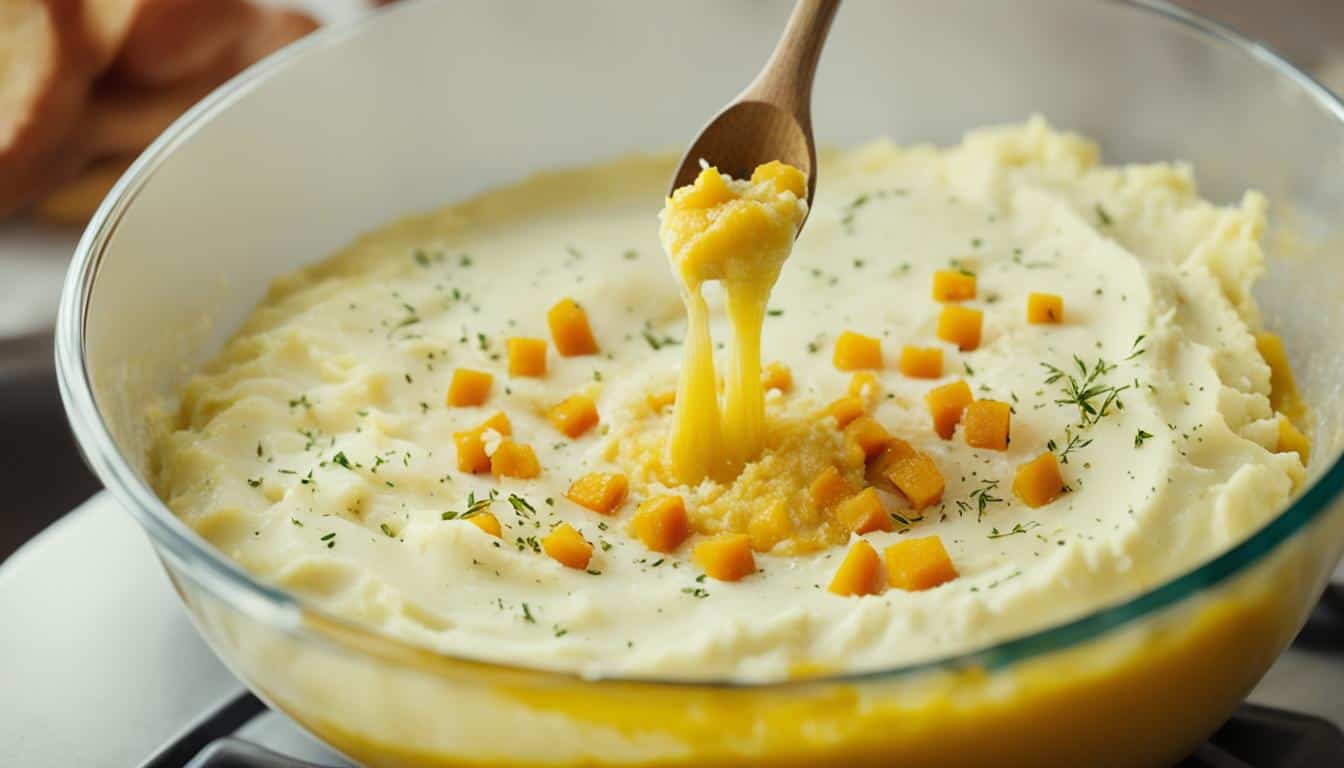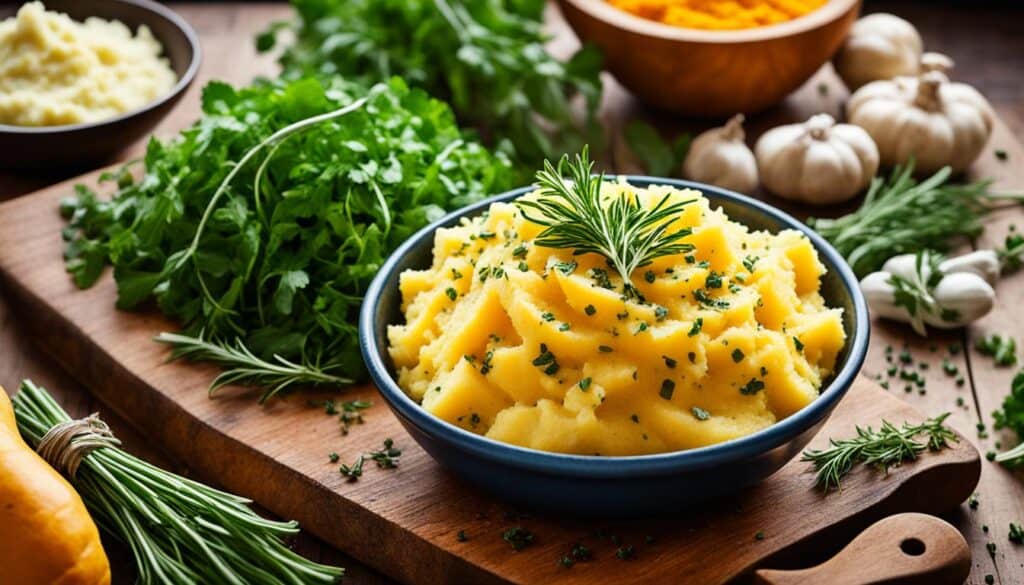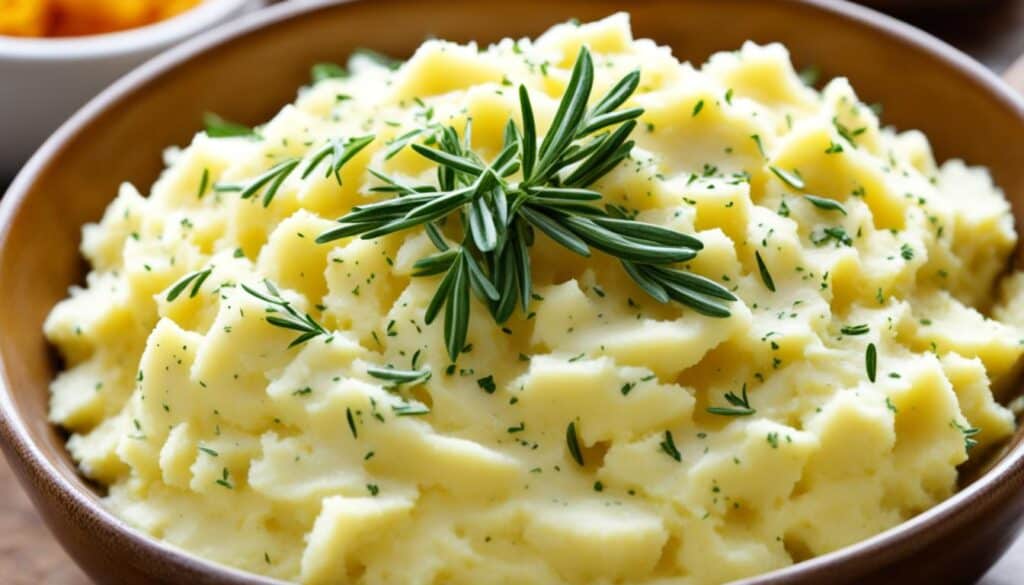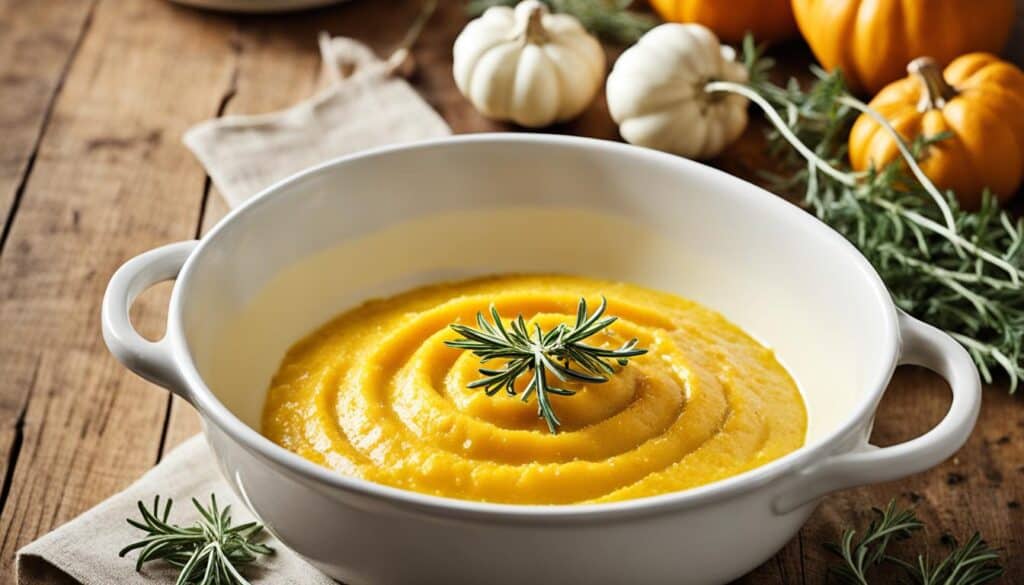Mashed potato squash, also known as white acorn squash, is a winter squash that has a creamy and flavorful flesh. When roasted and mashed, it closely resembles traditional mashed potatoes in texture and taste. But the surprising fact is that it has fewer carbs and calories, making it a healthier option for those watching their carbohydrate intake.
In this ultimate recipe guide, I’ll show you how to make creamy and savory mashed potato squash using different varieties of squash, such as butternut squash and acorn squash. Whether you’re looking for a seasonal side dish or a nutritious mashed veggie side, these recipes will elevate your meals and satisfy your cravings.
Key Takeaways:
- Mashed potato squash is a creamy and flavorful alternative to traditional mashed potatoes.
- It is low in carbs and calories compared to mashed potatoes, making it a healthier option.
- You can prepare mashed potato squash by roasting the squash and mashing the tender flesh.
- There are various variations and serving ideas for mashed potato squash to suit your taste preferences.
- Leftover mashed potato squash can be stored and reheated for future meals.
What is Mashed Potato Squash?
Mashed potato squash, also known as white acorn squash, is a winter squash that has a creamy and flavorful flesh. When roasted and mashed, it closely resembles traditional mashed potatoes in texture and taste. It can be cooked in various ways, including baking, roasting, or steaming, and it makes a delicious side dish for any meal.
How to Prepare Mashed Potato Squash
To prepare delicious and creamy mashed potato squash, follow these simple steps:
- Preheat the oven to 350°F.
- Cut the squash in half lengthwise and remove the seeds.
- Drizzle olive oil over each squash half and season with salt and pepper to taste.
- Place the squash halves cut side down on a baking sheet lined with parchment paper.
- Roast the squash in the preheated oven for about 1 hour, or until the flesh is tender. The roasted squash will have a lovely caramelized flavor.
- Remove the roasted squash from the oven and let it cool slightly.
- Scoop out the flesh from the squash halves using a spoon.
- Mash the roasted squash flesh with a fork or potato masher until it becomes creamy and smooth. The consistency should resemble traditional mashed potatoes.
- Add butter, salt, and pepper to taste for extra flavor. You can also experiment with other seasonings like herbs or spices to customize the taste to your liking.
And there you have it! Your homemade mashed potato squash is ready to be enjoyed. Serve it as a flavorful and nutritious side dish alongside your favorite main course or incorporate it into creative recipes for a creamy twist.
Enjoy the Creamy Goodness
Once you’ve mastered the art of preparing mashed potato squash, you’ll be rewarded with a delightful and wholesome dish. The roasted squash mash offers a creamy texture and a subtly sweet flavor that pairs well with a variety of meals. Whether you’re looking to incorporate seasonal ingredients, enjoy a healthier alternative to traditional mashed potatoes, or simply add some variety to your side dishes, creamy mashed squash is a winner.
Get Creative with Your Mashed Potato Squash
The beauty of mashed potato squash lies in its versatility. You can use it as a base and add various ingredients to customize the flavor. Consider adding roasted garlic for a savory twist, fresh herbs like thyme or rosemary for an aromatic touch, or a drizzle of maple syrup for a hint of sweetness. Don’t be afraid to experiment and create your own unique mashed potato squash recipes.
Variations of Mashed Potato Squash
Mashed potato squash is a versatile dish that can be customized to suit your taste preferences. With a few simple additions and substitutions, you can create unique and delicious variations of this savory mashed squash. Below are some ideas to inspire your culinary creativity:
1. Savory Herb Infusion
Enhance the flavor of your mashed potato squash by infusing it with savory herbs. Add a handful of freshly chopped herbs like rosemary, thyme, or sage to the mashed squash and mix well. The aromatic herbs will lend a beautiful fragrance and depth of flavor to the dish, making it even more delightful.
2. Spicy Garlic Kick
If you enjoy bold and zesty flavors, try adding a kick of spice and garlic to your mashed potato squash. Finely mince some garlic cloves and sauté them in olive oil until fragrant. Mix the sautéed garlic into the mashed squash along with a pinch of chili flakes or cayenne pepper. The combination of garlic and spice will give your dish a deliciously fiery twist.
3. Maple Roasted Delight
For a touch of sweetness and seasonal warmth, drizzle maple syrup over your mashed potato squash. Before roasting the squash, coat it with a generous amount of maple syrup, then proceed with the usual roasting process. The result will be a creamy and luscious squash puree with a hint of natural sweetness that complements the earthy flavors perfectly.
4. Seasonal Squash Medley
Take advantage of the abundance of squash varieties during the season and create a medley of mashed potato squash. Mix different types of squash, such as butternut squash, acorn squash, and delicata squash, to bring a burst of color and flavor to your plate. Each variety will contribute its unique characteristics, resulting in a visually captivating and delicious mashed squash puree.
“The secret to a great mashed potato squash lies in experimenting with flavors until you find your perfect combination.”
Remember, the possibilities are endless when it comes to variations of mashed potato squash. Don’t be afraid to get creative and try new ingredients or flavor combinations. The more you explore, the more delightful surprises you’ll uncover in this versatile dish.
Where to Find Mashed Potato Squash
Mashed potato squash is a delightful and unique side dish that adds a creamy twist to traditional mashed potatoes. While it may not be as widely available as other squash varieties, there are several places where you can find this delectable ingredient for your culinary creations.
Local Farmers’ Markets and Organic Farm Stands
One of the best places to find mashed potato squash is at your local farmers’ markets or organic farm stands. These venues often showcase a wide variety of fresh, seasonal produce, including unique and specialty items like mashed potato squash. By purchasing from local farmers, you not only support local businesses but also get the freshest and most flavorful ingredients.
Specialty Grocery Stores
If you can’t find mashed potato squash at farmers’ markets, specialty grocery stores might be your next best option. These stores typically carry a diverse selection of fruits, vegetables, and other culinary treasures. Look for the produce section or ask the store staff for guidance on where to find mashed potato squash. Some stores may even have it labeled as a seasonal specialty item.
Online Platforms for Rare and Unique Produce
If all else fails, turn to the convenience of online platforms that specialize in rare and unique produce. There are various websites that connect consumers with farmers who grow hard-to-find ingredients, including mashed potato squash. Simply search for “buy mashed potato squash online” or explore specialized online marketplaces to discover a world of culinary possibilities.
Grow Your Own Mashed Potato Squash
If you have the space and resources, why not grow your own mashed potato squash? It can be a rewarding experience to plant, nurture, and harvest your own vegetables. Check with your local garden center or nursery for squash seedlings or seeds. With a bit of patience and care, you can enjoy the satisfaction of cultivating your own ingredients and creating delicious dishes straight from your garden.
Health Benefits of Mashed Potato Squash
Mashed potato squash not only delights your taste buds but also provides a plethora of health benefits. If you’re conscious of your carbohydrate intake, this creamy alternative to traditional mashed potatoes is a healthier option. Low in carbs and calories, mashed potato squash allows you to indulge guilt-free.
But that’s not all! It’s also packed with fiber, vitamins, and minerals that contribute to your overall well-being. The creamy goodness of mashed potato squash boasts high levels of vitamin A and vitamin C, which are essential for healthy skin and a strong immune system. Additionally, it contains potassium and magnesium, supporting proper muscle function and maintaining healthy blood pressure levels.
By substituting mashed potato squash for regular mashed potatoes, you can easily incorporate more vegetables into your diet. This is a great way to increase fiber intake and add a flavorful and satisfying side dish to your meals.
So, why not enjoy the creamy mashed squash goodness guilt-free while reaping its numerous health benefits?
Benefits of Mashed Potato Squash:
- Low in carbs and calories compared to traditional mashed potatoes
- High in fiber, promoting healthy digestion
- Rich in vitamin A and vitamin C for radiant skin and a strong immune system
- Contains potassium and magnesium for proper muscle function and blood pressure regulation
- Provides a nutritious way to incorporate more vegetables into your diet
Serving Ideas for Mashed Potato Squash
Mashed potato squash is incredibly versatile and can be served in a variety of ways. Whether you’re looking for a delicious squash side dish or a flavorful mashed veggie side, the creamy texture and savory flavor of mashed potato squash will elevate any meal. Here are some serving ideas to inspire you:
- Pair it with roasted chicken for a comforting and satisfying meal.
- Serve it alongside a grilled steak to add a flavorful and nutritious element to your plate.
- Enjoy it as a side dish with baked salmon for a healthy and flavorful combination. The creamy mashed potato squash complements the delicate flavors of the salmon.
- For a vegetarian option, serve mashed potato squash as a standalone side dish. It pairs perfectly with sautéed vegetables, adding a creamy element to the dish.
- Add it to a fresh green salad for a unique twist. The smooth and velvety texture of the mashed potato squash adds richness to the salad.
With its versatility and ability to enhance any meal, mashed potato squash is the perfect addition to your dining table. Its creamy texture and savory flavor make it a natural companion to a wide range of main dishes and salads.
Enjoy the goodness of mashed potato squash in these creative and delectable serving ideas. Let your culinary imagination run wild and experiment with different combinations to create a memorable dining experience.
Storing and Reheating Mashed Potato Squash
If you have leftovers from your delicious mashed potato squash creation, don’t worry! You can easily store and reheat it for future meals. Here’s how:
- Storage: Place the mashed potato squash in an airtight container and store it in the refrigerator. It can be kept for up to 3-4 days, allowing you to enjoy the flavors of seasonal squash puree throughout the week.
- Reheating in the Microwave: Transfer the desired amount of mashed potato squash to a microwave-safe dish. Heat it in the microwave in 30-second intervals, stirring in between, until it’s warmed through. This method is quick and convenient when you’re short on time.
- Reheating on the Stovetop: If you prefer to reheat your roasted squash mash on the stovetop, simply transfer it to a saucepan. Heat it over low heat, stirring occasionally, until it reaches your desired temperature. The gentle heat will help maintain the creamy consistency of the mashed potato squash.
Note: During reheating, you may notice a slight change in texture, but the flavors will still be delicious and enjoyable. Make sure to taste and adjust the seasoning if needed before serving.
Continue reading for more creative serving ideas and the exciting health benefits of mashed potato squash!
Conclusion
In conclusion, mashed potato squash is a delicious and versatile alternative to traditional mashed potatoes. With its creamy texture and savory flavor, it can be a delightful addition to any meal. Whether you’re looking for a seasonal squash puree or a comforting mashed veggie side, these recipes will elevate your culinary experience.
By using different varieties of squash, such as butternut squash and acorn squash, you can create unique flavors and cater to your taste preferences. The possibilities are endless when it comes to experimenting with mashed potato squash. Try adding garlic, herbs, or spices to enhance the taste, or even a touch of maple syrup for a hint of sweetness.
Not only is mashed potato squash delicious, but it is also a nutritious choice. It is low in carbs and calories compared to regular mashed potatoes, making it a healthier option. Additionally, it is rich in fiber, vitamins, and minerals, providing added nutritional value to your meals.
So why not give mashed potato squash a try? Enjoy the flavorful goodness of mashed potato squash and savor the richness of the season. Whether it’s squash mashed potatoes or butternut squash mashed potatoes, you won’t be disappointed with this delightful twist on a classic side dish.










Leave a Reply